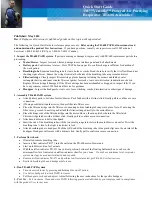"Camel" Liquid Ring Medical Vacuum
Medical Systems
A-3
A.2 Description
This bulletin contains information for owners and operators of Nash "Delta" EC series vacuum pumps. This
information includes a description of how to operate and maintain these vacuum pumps.
A.2.1 How the Nash vacuum pump works
The "Delta" series model EC liquid ring vacuum
pump consists of a cylindrical body within which a
rotor with fixed blades rotates, with the rotor axis
being eccentric to the body. The service liquid,
usually water, is spun by the rotor and produces a ring
of liquid that rotates concentrically within the body.
Because of the eccentricity between the body and the
rotor, buckets or chambers are formed with a
progressively increasing and decreasing volume, thus
producing vacuum and pressure. In this way gasses
are drawn in and discharged. During operation,
service liquid must continuously be admitted to the
pump in order to absorb the heat of compression and
to compensate for the volume of liquid exhausted
together with the gas through the discharge port. To
obtain the published performances, the service liquid
temperature should be 60°F (15°C). When water is
used as the service liquid, the inlet vacuum should not
be higher than 29"Hg. to prevent cavitation.
A.3 Application
A.3.1 Operation as a vacuum pump
The "Delta" EC pumps can handle gasses compatible with the specified material of construction. Small quantities of
liquid and non-abrasive solids can also be carried over with the gas. If water is used as the service liquid at a
temperature of 60°F (15°C) and with atmospheric discharge pressure (1013 mbar), the minimum pressure at the
inlet port is approximately 29" Hg (33mbar). Lower inlet pressures can be obtained if a gas ejector is fitted to the
inlet of the pump. Refer to published performance curves for pump capacity and absorbed power at the desired
vacuum level. The minimum inlet pressure that can be achieved is dependent upon the vapor pressure of the service
liquid. When the vapor pressure is very close to the inlet pressure, cavitation may occur in the pump. If cavitation
occurs, as indicated by unusual noise coming from the pump at high vacuum levels, it is recommended that an anti-
cavitation bleeder be fitted in the suction line.
WARNING:
Do not operate the pump for prolonged periods of cavitation. Prolonged
periods of cavitation will cause internal erosion and will result in serious
damage to the pump.


















